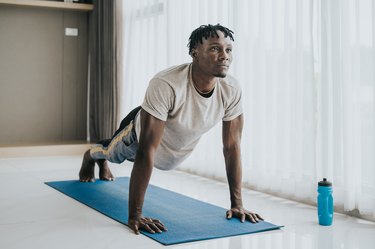
Weak, achy and unstable shoulders can result from an injury, inactivity or poor posture. The scapula, or shoulder blade, is one of the main support systems for the shoulder, and stabilizing it is an important part of building strong shoulders.
After an injury, your doctor or physical therapist may advise doing daily scapular stabilization exercises (similar to the ones listed below) at home. Just make sure you double check with them first to make sure you're cleared for physical activity and to get more personalized recommendations.
Video of the Day
Bonus: These exercises are also useful for people who don't have an injury but would like to build stronger shoulders and a solid upper back.
1. Scapular Push-Up
This move activates your serratus anterior muscle, which is an important scapular (aka shoulder blade) stabilizer, according to Winnie Yu, DPT, CPT, a physical therapist at Bespoke Treatments. This muscle is integral to proper shoulder movement, especially as you make forward and upward motions.
"By maintaining strength in this muscle, you can help reduce your risk of neck, shoulder and upper-back pain," she says.
- Come into a high plank position, hands in line with your shoulders and body in a straight line from head to heels.
- Keep your elbows locked and reach your chest toward the ground so your shoulder blades come together.
- Then, push your hands into the ground and pull your shoulder blades apart, pulling your chest back in. That's one rep.
Tip
To make this move a little easier, you can modify by coming down to your knees.
2. Band Pull-Apart
This exercise helps strengthen the muscles on the back of your body (your posterior chain). These muscles include the middle trapezius (on your upper back) and rhomboids (on your upper back and neck), which are crucial for maintaining stable shoulder blade and shoulder positioning, according to Yu.
- Stand with feet hip-distance apart, core muscles tight. Hold a long-loop band in both hands at chest height, shoulder-width apart.
- Pull the band in opposite directions, drawing your shoulders back and down.
- Drive your hands farther apart from each other against the resistance.
- Hold for a second, then slowly release.
3. Superman
Along with your trapezius, this exercise helps activate your deltoid, which protects the shoulder by maintaining its position, helping protect you from injuries like dislocations, Yu says. This move also activates the muscles across your spine.
- Lie down on your stomach with your arms extended straight ahead, biceps along your ears.
- Lift your arms, chest and legs off the floor, keeping your arms and legs straight.
- Squeeze your shoulder blades back and down.
- At the same time, squeeze your glutes to lift your legs.
- Hold for one to five seconds, then release.
4. Long-Loop Row
This exercise primarily targets the middle and lower trapezius muscles, which stabilize the shoulder, shoulder blade and neck, Yu says.
"By improving strength in these muscles, you can reduce your risk of overusing your upper trapezius, which commonly compensates for weaker neighboring muscles," she says. "Overusing your upper traps can lead to tightness, decreased flexibility, and trigger points and is often associated with neck and upper back pain and even headaches."
- Anchor a long-loop resistance band to a stable object or around the bottom of your foot.
- Hold the other end of the band with your arms close to your sides, elbows bent to 90 degrees.
- Keeping your elbows close to your body, pull them back, squeezing your shoulder blades together.
- Reverse the motion with control and return to the starting position to repeat.
5. External Shoulder Rotation
External rotations target the rotator cuff muscles, which is another important stabilizer in your shoulder, helping you maintain full range of motion, according to Yu.
"If you are dealing with a shoulder injury, opt for variations of this exercise with your arm down by your side," she says. "For anyone who wants a progression of this exercise, I recommend increasing the band resistance, trying this on a cable column, or using a dumbbell to further improve your rotator cuff strength."
- Anchor a long-loop resistance band to a stable object or around your right foot.
- Hold the free end of the band in your right hand with your elbow bent at 90 degrees, palm facing down.
- Raise your elbow to shoulder height.
- Slowly pull the band and raise your hand toward the ceiling so that your palm faces away from your body.
- Slowly return your hand back to the starting position and repeat.
Tip
As you do this exercise, keep your elbow locked at shoulder height the whole time. If this feels too difficult, swap for a lighter resistance band or perform the move with no weight at all.